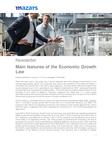
Main features of the Economic Growth Law
Much has been said in the press and in social networks about the alleged inconvenience of the recently approved tax reform. The issue was even part of the conditions of the strike committee, a committee that warned that if the reform were approved, marches would intensify throughout the country because such norm -according to Iván Cepeda's statements to RCN- "would grant benefits and exemptions to very powerful conglomerates". The same opinion is held by Sergio Clavijo, former president of Anif, when he stated to “Semana” magazine (Ed. 1966) that "(...) I have certain reservations about the issue of excessive concessions to the business world. It seems to me that this Government is going too far with the issue of investor confidence 2.0".
On the contrary, Luis Alberto Moreno, head of the Inter-American Development Bank (IDB), indicates that "(...) the bet on greater growth with the last reform is a correct bet" (Semana, Ed. 1966). The purpose of this article is to objectively review the main features of the recently approved tax reform and thus reach a supported conclusion regarding the convenience or not of having processed and approved it.
Law 2010 of 2019 (Economic Growth Law), as it is known, was a law that was urgently processed to adopt as permanent legislation the provisions of Law 1943 of 2018 (Financing Law) which was, in turn, declared unconstitutional by Ruling C-481 of 2019, issued by the Constitutional Court due to formal flaws in its legislative process. The initial purpose of processing the Financing Law was to guarantee the country's fiscal sustainability by obtaining additional revenues of $14 trillion and thus be able to finance the budget approved for 2019 ($259 billion), thus making the fiscal rule viable and preserving the sovereign investment grade rating. This Financing Law, unlike many of the previous tax reforms, was intended to use fiscal policy to dynamize the economy and thus begin a process of substitution of the Nation's current revenue sources. This long-term bet is intended to replace Colombia's dependence on oil and other mineral resources with income generated by talent, agriculture, tourism, and large-scale investment projects. To this end, it was essential to generate tax benefits (limited in time) to these sectors, so that they could have a sufficiently attractive incentive to be able to take off and thus generate employment and development in the most remote regions.
In order to initiate the recovery of the economy -via business development-, several benefits and fiscal stimuli with different objectives were created through the two aforementioned norms, plus Law 1955 of 2019 (National Development Plan): (a) some aimed at the development of various economic sectors of national relevance conditioned, among other things, to the generation of direct and formal employment; (b) others directly aimed at the generation of formal employment; (c) others aimed at the recovery of areas affected by conjunctural phenomena; and (d) others aimed at the industrialization and preservation of the company. As an example of the first, exemptions were created for seven years for orange economy companies and for ten years for investments in the agricultural sector, as well as a preferential rate of 9% for hotels (for a term of ten years in municipalities with more than 200,000 inhabitants and twenty years in municipalities with less than 200,000 inhabitants) and for agrotourism activities, marinas, and eco-parks.
As an example of the latter, special deductions of up to 120% were created for salary payments of persons (over 18 and under 28 years of age), deductions for special contributions for education to employees and the double benefit to deductibility and discount for hiring professionals with doctorate degrees in scientific research projects approved by the National Council for Tax Benefits in Science and Technology. As an example of the third ones, the Special Economic and Social Zones (ZESE) regime was created -which today includes companies in the health and tourism sectors- with the purpose of industrializing all the departments that share a border with Venezuela (as well as the capital cities with the highest unemployment rate) to contain the phenomenon of unemployment due to massive migration. As an example of the quarters, the ratification of the VAT discount benefit for the acquisition of real productive fixed assets (which will boost the industrialization of the country, thus generating more employment), the accelerated dismantling of the presumptive income system and the reduction of corporate income tax rates may be mentioned.
The effects of the Financing Law were overwhelming; collections reached $158.5 billion ($17.5 billion above the target for 2019) and economic growth was 3.3%, much higher than the 2.6% of 2018 and 1.4% of 2017. Following the tax incentive policy deployed by the Government, and as credited by the Dane, "the orange economy gave 539,933 jobs during 2018" (“El Tiempo” 16/12/2019). Also, according to an Ernst & Young Capital Confidence Barometer, Colombia "ranks second in the top 5 of preferred destinations for entrepreneurs, above Canada, Germany and the United Kingdom". This is shared by the head of the IDB when he states that "in economic terms [Colombia] is one of the most attractive countries in the region in comparison with the large Latin American economies that ended the year with negative growth or practically zero" (“Semana”, Ed. 1966).
The 2010 Law is a pro-business law that promotes economic development through the granting of tax benefits to companies that are, in the end, the ones that generate employment in the country. It is also a law that offers several tax incentives and reliefs to individuals (such as the three days without VAT, the non-taxation of the inflationary component of financial returns, the deductibility of interest paid to Icetex, among others), thus generating a greater purchasing power to individuals.


